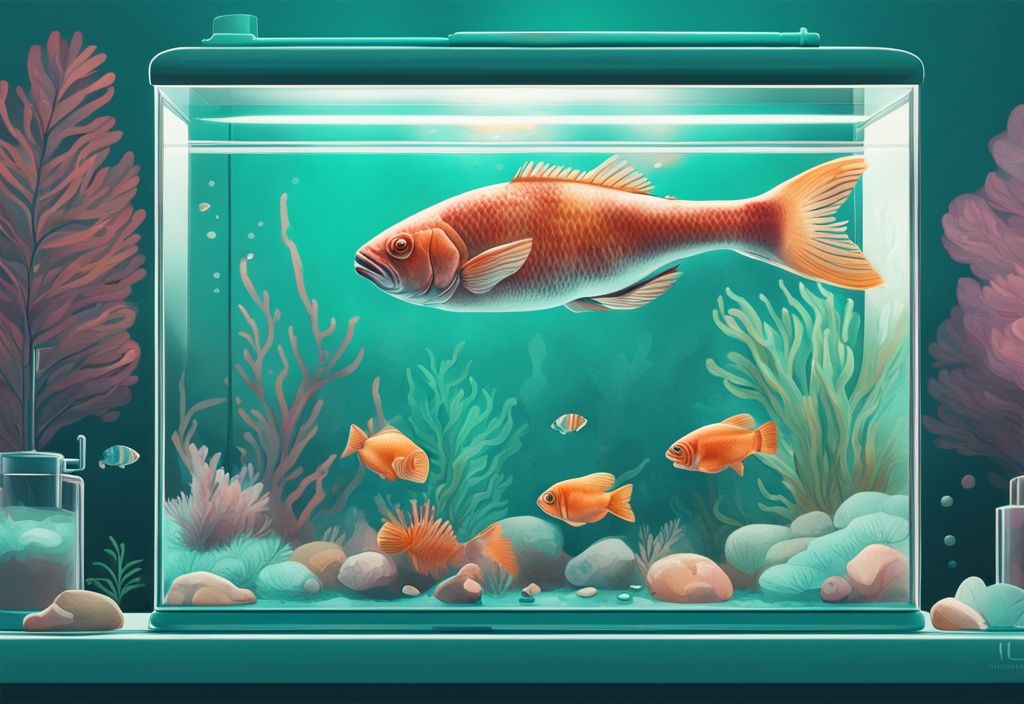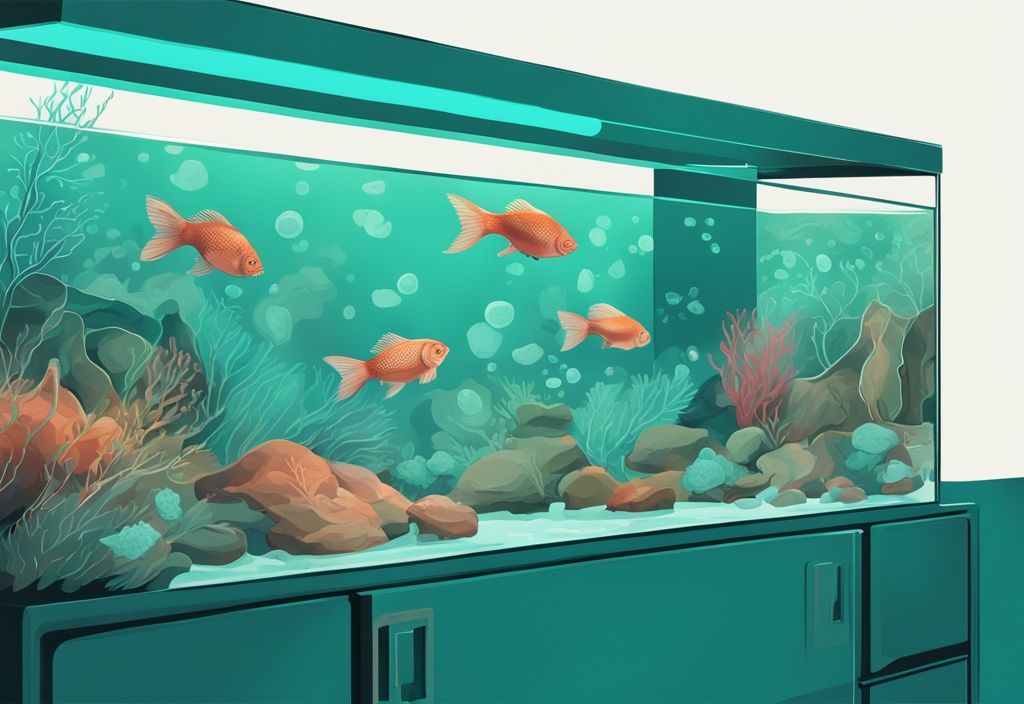Did you know that not all bacteria in your fish tank are harmful? As a Marine Biologist, I’ve devoted two decades to deciphering underwater ecosystems, and I can assure you that introducing beneficial bacteria to your fish tank can be a game-changer. By maintaining the right balance, these unseen heroes can significantly improve the water quality, keep your fish healthy, and ultimately, result in a vivacious aquarium that echoes the vibrancy of the sea itself.
This article will explore the role of these beneficial microorganisms in depth, equipping you with the knowledge to manage an aquarium teeming with life. Whether you’re a seasoned aquarist dealing with high ammonia levels or a beginner looking to keep your fish stress-free, you’ll find the solution right here.
So, let’s dive right in, to uncover the hidden magic of beneficial bacteria for fish tanks and how it can transform your aquatic world.
The Role & Importance of Beneficial Bacteria in Fish Tanks
Maintaining the delicate balance of beneficial bacteria in fish tanks is crucial for a thriving aquatic environment. This section delves into understanding the balance between good and bad bacteria, and why beneficial bacteria are vital for aquarium health.
Understanding the Balance between Good and Bad Bacteria
In a fish tank, achieving the right balance between beneficial bacteria and harmful bacteria can mean the difference between a healthy habitat and a toxic one. Beneficial bacteria, such as Nitrosomonas and Nitrobacter, perform an indispensable role in breaking down hazardous waste products. It’s fascinating how Nitrosomonas convert harmful ammonia into nitrites, and subsequently, Nitrobacter takes over to convert these nitrites into the less toxic nitrates. This entire process is like having a built-in waste management system that prevents the accumulation of lethal substances that could otherwise jeopardize your fish and other aquatic organisms.
Conversely, pathogens, or harmful bacteria, can wreak havoc by causing diseases and creating conditions that are less than ideal for your fish. These malevolent microorganisms can create an unhealthy environment, increasing your fish’s vulnerability to illness. Knowing and managing this fine line between good and bad bacteria is imperative for the well-being of your aquatic pets.
Why Beneficial Bacteria are Vital for Aquarium Health
The presence of beneficial bacteria for fish tanks is akin to having a dependable health support system within your aquarium. These bacteria are masters at converting toxic ammonia from fish waste into less harmful compounds like nitrites and nitrates. Imagine trying to keep your living space pristine without any cleaning supplies—sounds impossible, right? That’s essentially what beneficial bacteria do for your tank.
These bacteria prefer to colonize on surfaces such as filter media, substrate, and decorations, rather than floating freely in the water. This colonization is vital because it ensures that the bacteria are where they are most needed to effectively break down waste products.
One of the most incredible benefits of maintaining a robust population of beneficial bacteria is their ability to stabilize water quality and support a secure environment for your fish. Efficient waste processing by these microbes prevents disease, encourages stability, and even enhances the immune systems of your aquatic residents. If you ever notice cloudy water or fish that look unwell, it’s a telltale sign that your bacterial balance might be off. Addressing these imbalances promptly can restore harmony within your tank ecosystem.
In essence, beneficial bacteria are not just nice-to-have components in your fish tank; they are essential for ensuring the longevity and health of your aquatic ecosystem. With proper management and cultivation of these bacteria, you can prevent a host of problems and foster a thriving, vibrant fish tank.
Starting Your Aquarium: The Nitrogen Cycle & Beneficial Bacteria
An Overview of the Nitrogen Cycle and Its Key Players
The nitrogen cycle is a fundamental process in maintaining a healthy fish tank ecosystem, primarily driven by beneficial bacteria for fish tanks. This cycle transforms toxic ammonia, produced by fish waste, into less harmful compounds through a fascinating biological sequence.
Picture this: Nitrosomonas bacteria as the diligent janitors who convert ammonia into nitrite. While nitrite is still harmful, it’s a necessary step. Next, Nitrobacter bacteria step in as the skilled caretakers, converting nitrite into nitrate. Nitrate, being less harmful, can be utilized by aquarium plants, aiding in maintaining a balanced environment. Establishing a stable colony of these beneficial bacteria is critical to preventing toxic spikes and safeguarding your aquatic companions.
Steps of the Nitrogen Cycle: From Ammonia to Nitrate
In the nitrogen cycle, everything starts with fish excreting ammonia, a highly toxic substance. Here’s where the beneficial bacteria for fish tanks become your best allies. Nitrosomonas bacteria swiftly convert ammonia into nitrite, reducing the immediate toxicity. Then, Nitrobacter bacteria step up, transforming nitrite into nitrate. For aquarium enthusiasts looking to maintain a clean environment, understanding the role of these bacteria is crucial, especially when considering the [best fish for tank cleaning]. Although nitrate is less harmful, it also becomes a valuable nutrient for plants within your aquarium, creating a more vibrant and stable ecosystem. These steps clearly illustrate the indispensable role of beneficial bacteria in converting harmful substances and maintaining safe water conditions.
Accelerating the Tank Cycling Process with Beneficial Bacteria
Cycling a new tank typically requires 4-6 weeks to establish a sufficient population of beneficial bacteria for fish tanks. But, there are ways to fast-track this process.

Think of commercial bacterial supplements as your secret weapon. These products are specifically designed to quickly introduce a stable bacterial population, drastically cutting down the initial cycling period. Even better, consider transferring filter media from an established aquarium to give your new tank a jump start. These methods ensure that beneficial bacteria are efficiently established, maintaining water quality and preventing toxicity during the critical early stages of your aquarium setup.
Managing Your Bacterial Population Effectively
Cleaning Practices to Safeguard Beneficial Bacteria
Beneficial bacteria for fish tanks play a pivotal role in breaking down harmful waste products and sustaining water quality. These bacteria establish colonies on surfaces such as filter media, gravel, and decorations. Over-cleaning can inadvertently eliminate these vital colonies, so it’s crucial to find a balance in your cleaning practices.
When tidying up your tank, use moderate cleaning methods to preserve beneficial bacteria. For example, rinse your filter media in tank water rather than tap water. Tap water can contain chlorine or other chemicals that could kill beneficial bacteria. Avoid scrubbing tank surfaces too vigorously, as this might dislodge and reduce your bacterial populations. Regular, moderate water changes complement the nitrification process, preventing harmful substance buildup without disturbing established bacterial colonies.
Regulating Parameters: Water Changes, Filter Maintenance, and Overfeeding
To sustain a thriving environment with beneficial bacteria for fish tanks, regularly monitoring water parameters is essential. Keeping tabs on ammonia, nitrite, and nitrate levels helps ensure that the water remains healthy for both your fish and beneficial bacteria.
Overfeeding is a frequent issue that can result in excess waste and elevated ammonia levels, which can overwhelm biological filtration. Feed your fish sparingly, only offering as much food as they can consume in a few minutes to reduce waste production.
Proper filtration is another cornerstone for a healthy bacterial environment. Regular filter maintenance is indispensable, but avoid replacing all filter media simultaneously. Doing so could cause a bacterial colony collapse. Instead, stagger the replacement of filter media, allowing time for new colonies to establish.
Regular, partial water changes not only maintain water quality but also support the beneficial bacteria by providing them with the optimal conditions to thrive while keeping harmful substances in check.
Remember, creating a balanced ecosystem in your fish tank is all about maintaining harmony between cleaning, feeding, and monitoring, ensuring that these beneficial bacteria can help you achieve a vibrant and healthy aquarium.
Sources of Beneficial Bacteria: How to Boost Your Colony
Ensuring a thriving community of beneficial bacteria for your fish tank is vital for maintaining a balanced and healthy environment. This section will explore the main sources of these bacteria, assessing their pros and cons.
Natural vs. Commercial Sources: Pros and Cons
Beneficial bacteria for fish tanks come from two primary sources: natural and commercial.
Natural Sources:
- Utilizing natural sources such as established aquariums, live plants, or transferring filter media can be incredibly cost-effective. By leveraging existing bacterial colonies from other healthy tanks, you can foster a stable and gradual establishment of bacteria that matches your tank’s ecosystem.
- Using natural methods promotes a slow but steady colonization process, beneficial for maintaining the overall balance. It’s often the gentlest way to introduce beneficial bacteria without disrupting the natural pace of your tank’s development.
- However, the downside to natural methods is the time it takes for bacteria to reach adequate levels to handle the bioload. If you’re in need of a quick bacterial boost, this slower approach might not be ideal.
Commercial Sources:
- Commercial sources, like bottled bacteria products, offer convenience and a rapid establishment of bacterial populations. These products deliver a concentrated dose of beneficial bacteria, effectively speeding up the cycling process in new tanks.
- The major advantage of commercial bacteria is time efficiency. They can drastically cut down the period needed to establish a stable bacterial colony, making them perfect for new setups or urgent situations where swift action is necessary.
- However, it’s worth noting that commercial products can be more costly. Their effectiveness can also vary based on the brand and correct application.
Making the Most Out of Bottled Beneficial Bacteria Products
Maximizing the effectiveness of bottled beneficial bacteria products involves following a few key practices.

- Follow the dosage instructions: Always adhere to the manufacturer’s guidelines to avoid overdosing, which can lead to imbalances and potentially harm your tank’s environment.
- Use in specific scenarios: Bottled bacteria are particularly beneficial when introducing new fish, post-medicating your fish, and during water changes. These situations can disrupt existing bacterial colonies, so supplementation helps maintain stability.
- Proper storage: Some products require refrigeration after opening. Maintaining the correct storage conditions is crucial to preserve the viability of the bacteria, ensuring their effectiveness when added to your tank.
By recognizing the pros and cons of natural versus commercial sources and learning how to use bottled products effectively, you can foster a thriving bacterial colony in your fish tank. Implementing these strategies will aid in maintaining a healthy and balanced aquatic environment.
Best Practices for Cultivating Beneficial Bacteria in Your Fish Tank
Creating a harmonious, thriving fish tank requires understanding and nurturing beneficial bacteria, which play a crucial role in maintaining a balanced environment. Here’s how to do it:
Adding Fish Gradually for Balanced Bacteria Growth
Introducing fish slowly to a new aquarium is vital to allow the beneficial bacteria for fish tank to adjust to the increased waste levels. Imagine it as moving into a new neighborhood—the residents (bacteria) need time to acclimate to the new inhabitants (fish).
Adding too many fish at once can overwhelm the bacteria and disrupt the nitrogen cycle. Start with a small number of hardy fish to establish a stable bacterial population. Monitor water parameters tirelessly during this phase to ensure ammonia and nitrite levels are safe.
Gradual fish addition supports bacteria growth and prevents sudden spikes in harmful substances, fostering a stable environment for your aquatic friends.
Moderate Feeding Practices to Boost Healthy Bacteria
Feeding your fish sparingly is essential in maintaining water quality and boosting the growth of beneficial bacteria for fish tank. Overfeeding can lead to an overwhelming production of waste, causing detrimental spikes in ammonia and nitrite levels.
It’s critical to feed only what your fish can consume within a few minutes. Unfinished food should be promptly removed to prevent decay and toxin release. Think of it like cleaning up after a meal to avoid a messy kitchen.
By sticking to moderate feeding practices, you support a balanced bacterial population, ensuring a cleaner, healthier aquarium.
Protecting Beneficial Bacteria During Water Changes
During water changes, using dechlorinated water or water conditioners is crucial to safeguard the beneficial bacteria for fish tank. Tap water, rich in chlorine and chloramines, can be harmful, disrupting the nitrification process.
Regular water changes are imperative to maintain a stable, healthy environment but should remain moderate to avoid disrupting bacterial colonies. Aim for a weekly water change of about 20-25%. This process helps remove toxins without affecting the bacteria on filter media, gravel, and decorations.
Regular, moderate water changes contribute to a balanced, thriving aquarium ecosystem brimming with life.

How Maintaining Beneficial Bacteria Benefits Your Fish Tank
Having a stable, well-maintained bacterial colony in your aquarium is paramount. The subsections below delve into the multifaceted advantages these beneficial microbes offer, ranging from stress prevention in your aquatic pets to ensuring long-term stability.
Stress and Disease Prevention through Balanced Bacteria
A healthy bacterial population in your fish tank plays a crucial role in establishing a stable and natural environment for your aquatic pets. These beneficial bacteria efficiently break down waste products, ensuring water quality remains high. This effective waste management reduces harmful ammonia and nitrite levels, which are major stress-inducing factors for fish.
By maintaining optimal water conditions, these bacteria prevent stressful situations for the fish, fostering a calm and thriving ecosystem.
Moreover, the presence of beneficial bacteria for fish tanks robustly supports the fishes’ immune systems. Healthy water quality, achieved through the diligent work of these bacteria, minimizes the likelihood of disease outbreaks. Pathogens find it challenging to thrive in well-balanced environments, leading to fewer instances of illness and thereby enhancing the vitality and longevity of your fish.
Long-term Aquarium Stability with Beneficial Bacteria
A stable bacterial colony is the bedrock of a balanced aquarium ecosystem. Beneficial bacteria for fish tanks continuously convert toxic substances into less harmful compounds, ensuring the ongoing stability of the aquatic environment. This constant biological filtration helps maintain equilibrium, preventing sudden spikes in ammonia or nitrite levels that can jeopardize the health of your fish.
Regular monitoring and maintenance routines are essential to sustain this long-term stability. Practicing consistent care—such as routine water changes, avoiding overfeeding, and ensuring proper filtration—supports the thriving bacterial colonies. This diligence maintains water quality and reinforces the resilience of the ecosystem.
By fostering a stable environment, you set the stage for a flourishing aquarium that promises sustained health and beauty for your aquatic inhabitants.
Frequently Asked Questions About Beneficial Bacteria for Fish Tanks
Beneficial bacteria are crucial to maintaining the health and balance of your aquarium’s ecosystem. Understanding how to manage these tiny yet mighty organisms can lead to a thriving tank environment. Here’s a deeper dive into some common questions about beneficial bacteria for fish tanks.
Can I Add Beneficial Bacteria While My Fish are in The Tank?
Absolutely, you can add beneficial bacteria to your fish tank even when your finned friends are swimming about. In fact, adding beneficial bacteria for fish tanks is not only safe but vital for maintaining balanced bacterial levels, which in turn significantly improves overall water quality. Think of it as giving your tank a helping hand to stay pristine and healthy.
What Are the Signs of an Imbalanced Bacteria Population?
Signs of an imbalanced bacteria population can be unsettling. Cloudy water is often one of the first red flags, resembling a hazy fog that just won’t clear. Elevated ammonia and nitrite levels are also indicators, posing serious risks to your fish’s health. If you’re a beginner, learning how to clean a fish tank can help prevent these issues. Your fish might exhibit stress or illness, such as swaying lethargically, losing appetite, or even showing visible gill damage. Analogous to a human feeling unwell in a polluted environment, fish too can suffer immensely.
How Often & When to Add Supplemental Bacteria to Your Tank?
Once your beneficial bacteria colonies are well-established, frequent supplements become unnecessary. However, there are specific circumstances when adding these bacteria becomes essential. Consider introducing additional bacteria when bringing new fish into the tank, after rounds of medication that could disrupt bacterial balance, and following significant water changes. It’s a bit like giving your aquarium a booster shot to maintain its health.
Pro Tip: Regularly monitor your water parameters. Your aquarium will thank you for the attention, letting you know if extra supplementation is needed through its clarity and the health of its inhabitants.
Conclusion: Harnessing the Power of Beneficial Bacteria
Beneficial bacteria for fish tanks are indispensable in cultivating a thriving aquatic environment. These microorganisms play a pivotal role in converting harmful fish waste into less toxic substances, thereby ensuring the health and well-being of aquarium inhabitants. Stabilizing ammonia and nitrite levels, they prevent toxic spikes that could otherwise wreak havoc on the ecosystem.
The long-term benefits of maintaining a robust bacterial colony are manifold. Beneficial bacteria aid in disease prevention by enhancing water quality, thereby minimizing stress and bolstering the immune systems of fish. The balanced environment they help sustain contributes to reduced stress in fish, fostering a natural and comfortable habitat.
Consistent care and proper management are crucial to harnessing the full potential of beneficial bacteria for fish tanks. This involves moderate cleaning practices and regular monitoring of water parameters to maintain an optimal bacterial balance. A thriving bacterial colony not only ensures a stable ecosystem but also supports the overall health and longevity of the aquarium, making it a cornerstone of aquarium management for both novice and seasoned aquarists alike.
